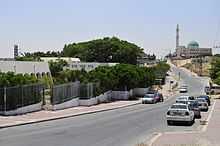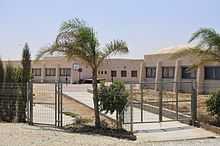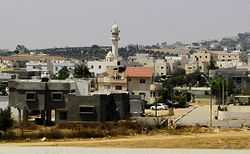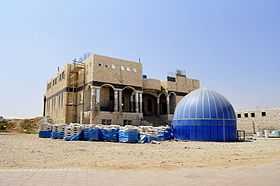Regional Council of Unrecognized Villages
The Regional Council of Unrecognized Villages of Negev (RCUV or RCUVN) is a political advocacy group that was established in 1997.[1][2] It represents the interests of the Bedouin population living in the unrecognized dispersed communities in the Negev Desert in southern Israel.[3]
Structure
This political advocacy group was created due to the need of the residents of the unrecognized Bedouin communities to promote their interests within the Israeli political system. Members of these communities belong to no municipalities of their own, and thus cannot elect representatives.
Israel refuses to recognize these localities for several reasons. The main reason is the planning issue - the state would like to see the Bedouin living in the planned settlements, like Rahat and Hura. But most of the unrecognized villages are dispersed far apart and are situated in unsuitable places - f.e. military fire zones, natural reserves, landfills, etc. Nevertheless, in the end the state wants to recognize the maximal possible number of these unrecognized settlements and build infrastructure in them. Another reason is an extremely high number of land ownership claims filed by the Bedouin making it impossible to recognize all of them. Negev Bedouin claim the ownership of land totaling some 600,000 dunams (60,000 hectares or 230 square miles) - it is 12 times the size of Tel Aviv.[4]
In 1997 inhabitants of these localities who felt the need for a representative community-based organization founded the RCUV.[5] Then the 45 participating dispersed localities had a total population of 76,000 inhabitants; these communities range in size from 500 to almost 5,000 residents.[6] The RCUV is supposed to be an elected body, and the residents of each community (village) elect a local committee of 3-7 persons, who become members of the general assembly of the RCUV. The general assembly democratically elects the chairperson and the executive committee once every 4 years.[7] To this day, the RCUV is the only body which seeks to represent the interests of residents of the unrecognized villages.
For a long period of time this organization was not recognized by the state apparently because of its anti-Israel stance - it accuses the state in racism and committing crimes, which cannot be considered as a constructive position.[8] Nevertheless its activities might have influenced the government policies to a certain extent and brought some real problems to the light. Now government seeks to involve the Bedouin in finding an ultimate housing solution for them via recognition of most of these previously unrecognized Bedouin communities in the Negev and offering an appropriate and just resolution of Bedouin land ownership claims.[9]
Background
In order to understand the role of this organization it's important to know the background of the Negev Bedouin.
Early sedentism
Negev Bedouins were originally a nomadic society engaged in herding, agriculture and sometimes fishing. Traditional Bedouin lifestyle began to change after the French invasion of Egypt in 1798. At the end of the 19th century, following the need to establish law and order in the Negev, the Ottoman Empire started forcing sedentarization of the Bedouins.
In 1858 a new Ottoman Land Law was issued that offered the legal grounds for the displacement of the Bedouin. Under the Tanzimat reforms the Ottoman Land Law of 1858 instituted an unprecedented land registration process. Few Bedouin opted to register their lands with the Ottoman Tapu, due to lack of enforcement by the Ottomans, illiteracy, refusal to pay taxes and lack of relevance of written documentation of ownership to the Bedouin way of life at that time.[10]
It was a fatal mistake since Israel has inherited and mainly implemented the Ottoman Land Law as the only preceding law frame. While determining the land ownership Israel relied mainly on Tabu recordings whereas most of the Bedouin land fell under the Ottoman class of 'non-workable' (mawat) land and thus belonged to the state under Ottoman law. Moreover, Israel nationalized most of the Negev lands, using The Land Rights Settlement Ordinance from 1969.[11][12]
Israel's policies regarding the Negev Bedouin at first included regulation and re-location. During the 1950s Israel has re-located two-thirds of the Negev Bedouins into an area that was under a martial law.[11] Bedouin tribes were concentrated in the Siyagh (Arabic for "the permitted area") triangle of Beer Sheva, Arad and Dimona.[13] In 1966 they were given Israeli citizenship and the state has started to build planned townships for them.
Government-planned townships

Between 1968 and 1989 Israeli government established urban townships especially for the Bedouin tribes of the Negev. Within a few years, half of the Bedouin population moved into the seven townships built for them. The largest Bedouin locality in Israel is the city of Rahat, it was established in 1971. Other towns include Tel as-Sabi (Tel Sheva) (established in 1969), Shaqib al-Salam (Segev Shalom) in 1979, Ar'arat an-Naqab (Ar'ara BaNegev) and Kuseife in 1982, Lakiya in 1985 and Hura in 1989.[14] But not all the Bedouin desired urban life.
Unrecognized villages
Those Bedouin who resisted sedentarization remained in their old scattered villages which are not recognized by the Israeli government and are thus ineligible for municipal services such as connection to the electrical grid, water mains or trash-pickup.[15] Some Bedouin insist on remaining in unrecognized villages in the hope of retaining their traditions and customs.

Many of the unrecognized Bedouin communities were created in the 1950s when the Israeli army resettled Bedouin from the Sinai desert. Construction in them was carried out sporadically, without any centralized planning, so, for example, no place was left for the community objects, such as schools, clinics or community centers.
Israeli government uses different means in order to attract the Bedouin into the planned settlements, both pleasant and unpleasant. For instance, it offers land lots at very attractive prices[16] and different bonuses. But sometimes the state is forced to implement coercive measures. Following the court order and all the legal procedure it demolishes houses built illegally on what it considers to be state lands. This is done in order to implement law and order in the Negev, as well as to build new settlements both for Jews and for the Bedouin, and improve life conditions of the Bedouin by moving them to townships with a developed infrastructure.
Formation
The RCUV was formed in the aftermath of 1996 events in the unrecognized village of Umm Batin. A group of local residents tried to resist government's demolition of houses built as a result of squatters' housing. During the relocation of the Bedouin and their active resistance three people were injured, including a child. Following this event, RCUV was created. It consisted of a local committee of traditional leaders joined by several "community professionals".[6]
The founders of the RCUV soon after took on developing a "Plan for the Development of Municipal Authority for the Arab Bedouin of the Unrecognized Villages in the Negev", as an alternative to the Israeli government's standard approach to relocation of residents of the unrecognized villages against their will.[6]
According to Human Rights Watch, when the Israeli Southern District Outline Plan (Tamam 4/14/2001) was first formulated, it completely ignored the existence and needs of the Bedouin in the unrecognized villages. After the Association for Civil Rights in Israel petitioned the Israeli Supreme Court in cooperation with the RCUV and the villagers it seeks to represent, the planning authorities acknowledged that Tamam had discriminated against the Bedouin.[17]
In July 2001 government planners agreed to meet with community representatives. However, Human Rights Watch says this process dragged on for over seven years, and despite some improvements, in 2008 the Plan still ignored the needs of most of the unrecognized villages.[17]
Establishment of Abu Basma Regional Council

Answering the housing need of the Negev Bedouin and as a part of the policy of step-by-step recognition of the unrecognized communities where it is possible, the State of Israel went on and initiated a creation of a new regional council whose sole purpose was to unite all the Bedouin communities that previously did not belong to other municipalities in order to solve their problems in a more organized way.
On September 29, 2003 Israeli government has adapted a new "Abu Basma Plan" (Resolution 881), according to which a new Abu Basma Regional Council was formed, unifying a number of unrecognized Bedouin settlements.[18] This resolution also regarded the need to establish seven new Bedouin settlements in the Negev,[19] literally meaning the official recognition of unrecognized settlements, providing them with a municipal status and consequently with all the basic services and infrastructure. The council was established by the Interior Ministry on 28 January 2004.[20]
Moreover, Israel is currently building or enlarging some 13 towns and cities in the Negev.[4] According to the general planning, all of them will be fully equipped with the relevant infrastructure: schools, medical clinics, postal offices, etc. and they also will have electricity, running water and waste control, but it takes time. Several new industrial zones are planned, some are already being constructed, like Idan haNegev on the suburbs of Rahat.[21] It will have a hospital and a new campus inside.[22]
Prawer plan
In September 2011, the Israeli government approved a five-year economic development plan called the Prawer plan.[23] One of its implications is a relocation of some 30.000-40.000 Negev Bedouin from areas not recognized by the government to government-approved townships. This will require Bedouins to leave ancestral villages, cemeteries and communal life as they know it.[24][25][26]
According to the PMO official press release, the plan is based on four main principles:
- Providing for the status of Bedouin communities in the Negev;
- Economic development for the Negev's Bedouin population;
- Resolving claims over land ownership; and
- Establishing a mechanism for binding, implementation and enforcement, as well as timetables.[23]
When the cabinet approved it, simultaneously it also approved a NIS 1.2 billion economic development program for Bedouin Negev whose main purpose is to support the Bedouin women and youth in the fields of employment since the Israeli government claims they will contribute to the increased economic growth of the entire Bedouin community. Much of the approved funds will be allocated for the development of industrial zones, establishment of employment centers and professional training. This claim has been resisted by Bedouin people.[26]
According to the Prawer plan, the present Bedouin communities will undergo a comprehensive planning process. The existing communities will be expanded, some unrecognized communities will be recognized and start to receive public services, while their infrastructure will be renewed. All these changes will be done in the framework of the Beer Sheva District masterplan. Most residents will be absorbed into the Abu Basma Regional Council. While the government claims that the nature of these future communities, whether agricultural, rural, suburban or urban will be decided in full cooperation with the local Bedouin and that relocated people will receive new residences, many Bedouin people have found new homes unsustainable, destructive of their communities—and have been forced out of their homes.[23][26]
The Prawer plan seeks to give an answer to numerous land claims filed by the Bedouin. It will offers significant compensation in land and funds - 50% of the claim (currently it's only 20% offered), while each claim will be dealt in a unified and transparent way provided by law.[23]
It is feared by many that implementation of this plan will lead to forced relocation of the Bedouin from the unrecognized communities in spite of promises that the relocation is done in full coordination with the Bedouin and is voluntary.
Other Bedouin have also been removed with less popular criticism. Good examples in this matter are Tirabin al-Sana and Segev Shalom. After a number of complicated agreements with the state all of the Bedouin of Tarabin clan moved into a township built for them - Tirabin al-Sana. Following negotiations, the Bedouin of al-'Azazme clan will take part in the planning of a new quarter that will be erected for them to west of Segev Shalom township, cooperating with The Authority for the Regulation of Bedouin Settlement in the Negev.[27]
Current role
According to Maha Qupty (2004), a RCUV coordinator,[28] the council builds community solidarity and mobilizes outside supporters to empower unrecognized villagers "to defend themselves against the onslaught of the State against their lands and livelihoods."[6]
The RCUV seeks to address:
- The government's treatment of 45 Bedouin villages as illegal "squats," and its residents as "trespassers";
- The failure to extend municipal services afforded all other Israeli citizens;
- The lack of community representation of the unrecognized villages in local councils, municipalities, planning and administrative bodies;
- Protection from home demolitions, uprooting, land confiscation, and transfer; and
- The Israeli national development plan and regional plans that ignore the existence of the villages.[6]
In addition, the RCUV is working with the Abu Basma Regional Council to assure that villages which are de jure recognized by the government receive de facto recognition through government allowances for herding and agriculture, and the provision of services within a reasonable time frame.
In 2008, the Goldberg Committee, the government body assigned to assess the status and future of the unrecognized villages, reported its recommendations. No member of the RCUV or of the unrecognized villages was included on the panel of the Goldberg Committee.[29] But the RCUV has worked to bring public pressure to bear on the Committee, from the outside.[30][31]
On the contrary, implementation of the Prawer plan has started from the full cooperation of the government with the Bedouin and several important agreements were made between the Bedouin and the State.[27]
See also
- Unrecognized Bedouin villages in Israel
- Negev Bedouin
- Political advocacy
References
- ↑ Regional Council for Unrecognized Villages - RCUV (Hebrew), The Center for Jewish-Arab Economic Development
- ↑ “Unrecognized” Villages of the Naqab
- ↑ About the RCUV
- ↑ 4.0 4.1 Bedouin information, ILA, 2007
- ↑ Patricia Golan, Built on sand, Jerusalem Report, June 26, 2012
- ↑ 6.0 6.1 6.2 6.3 6.4 Maha Qupty."Bedouin Unrecognized Villages of the Negev"; De la Marginación a la Ciudadanía, 38 Casos de Production Social del Hábitat, Forum Barcelona, Habitat International Coalition. Case study, 2004
- ↑ Internal Displacement Monitoring Centre
- ↑ Here is a quote from their official blog that shows the anti-state bias: "In coordination and cooperation with different institutions and groups, the council works today on building a broader network to confront the various destructive and racist governmental plans whose ultimate aim is to empty the Arab villages in the Negev of their inhabitants and confiscate all their lands."About the RCUV
- ↑ The Goldberg Commission
- ↑ Gershon Shafir, Land, Labor and the Origins of the Israeli-Palestinian Conflict 1882-1914. Cambridge: Cambridge University Press
- ↑ 11.0 11.1 Dor Fridman. "About the Negev Bedouins". LocalEconomySeminar.
- ↑ (Hebrew) Dr. Tobi Fenster, A summary stance paper on Bedouin land issues, written for "Sikkuy - for equal opportunity"
- ↑ Rebecca Manski."Criminalizing Self-Subsistence"; News from Within", Summer 2006
- ↑ Rebecca Manski. "THE NATURE OF ENVIRONMENTAL INJUSTICE IN BEDOUIN URBAN TOWNSHIPS: THE END OF SELF-SUBSISTENCE"; Life and Environment, 2006 (translation from Hebrew)
- ↑ "Off the Map: Land and Housing Rights Violations in Israel’s Unrecognized Bedouin Villages"; Human Rights Watch, March 2008 Volume 20, No. 5(E). Whole report: (PDF, 5.4 MiB)
- ↑ In Hura an 800 square meters land lot costs 60-65 thousand shekels ($15-16 thousand) for clan members or 22 thousand shekels ($5.5 thousand) for a demobilized soldier. Clan members’ transition to the village of Houra
- ↑ 17.0 17.1 "Off the Map: Land and Housing Rights Violations in Israel's Unrecognized Bedouin Villages"; Human Rights Watch, March 2008
- ↑ Beduin in Limbo The Jerusalem Post, 24 December 2007
- ↑ Government resolutions passed in recent years regarding the Arab population of Israel Abraham Fund Initiative
- ↑ The Bedouin Population in Transition: Site Visit to Abu Basma Regional Council Myers-JDC-Brookdale Institute, 28 June 2005
- ↑ Idan Hanegev Industrial Park
- ↑ Itamar Eichner, Harvard University makes aliyah, ynet, April 1, 2012
- ↑ 23.0 23.1 23.2 23.3 Cabinet Approves Plan to Provide for the Status of Communities in, and the Economic Development of, the Bedouin Sector in the Negev, PMO official site, September 11, 2012
- ↑ Al Jazeera, 13 September 2011, Bedouin transfer plan shows Israel's racism
- ↑ Guardian, 3 November 2011, Bedouin's plight: "We want to maintain our traditions. But it's a dream here"
- ↑ 26.0 26.1 26.2 http://blogs.independent.co.uk/2013/06/28/a-snapshot-of-the-lives-of-the-bedouin-tribe-of-%E2%80%9Cal-araqib%E2%80%9D/
- ↑ 27.0 27.1 Yanir Yagna, For the first time: Bedouin to take part in planning of their new neighborhood (Hebrew), Haaretz, July 1, 2012
- ↑ Palestinian Grassroots Organizations: Contact information and descriptions
- ↑ Rory McCarthy. "Nomadic bedouin fight to survive in the village which does not exist: Israel accused of discriminating against Negev desert clans"; The Guardian, 1 April 2008
- ↑ "RCUV's Recommendations for the Goldberg Commission!"; Save the Negev, 2006
- ↑ Council of Unrecognized Villages: Involve us in the outline plan to arrange status for our villages
External sources
- RCUV blog
- Government perspective on the Bedouin of the Negev
- Washington Report on Middle East Affairs
- Internal Displacement Monitoring Centre
- ZNet article on Devorah Brous, calling for government acknowledgement of the RCUV
- Lands of the Negev, a P.R. film prepared by Israel Land Administration on the official government perspective of challenges in the land management in Israel's southern Negev region
- Seth Frantzman, Presentation to Regavim about Negev
